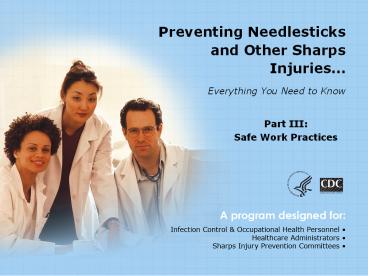Safe Work Practices - PowerPoint PPT Presentation
Title:
Safe Work Practices
Description:
Preventability of Needlesticks in NaSH Hospitals, June 1995 ... Use alternative cutting methods such as blunt electrocautery and laser devices when appropriate ... – PowerPoint PPT presentation
Number of Views:331
Avg rating:3.0/5.0
Title: Safe Work Practices
1
Preventing Needlesticks and Other Sharps
InjuriesEverything You Need to Know
- Part III
- Safe Work Practices
2
What Strategies Exist to Eliminate Sharps
Injuries?
- Eliminate or reduce the use of needles and other
sharps - Use devices with safety features to isolate
sharps - Use safer practices to minimize risk for
remaining hazards
3
Preventability of Needlesticks in NaSH Hospitals,
June 1995December 2003 (n10,661)
4
Injuries Related to Work Practices
- Injuries occur because of the following
- Passing or transferring equipment
- Recapping contaminated needles
- Colliding with coworkers
- Decontaminating/processing used equipment
- Injuries occur from sharps left in unusual
places - Laundry
- Mattresses
- Tables, trays, or other surfaces
5
The Sharps Safety Continuum
- Prepare to use the device the moment the sharps
are first exposed - Take precautions while using sharps
- Take precautions during cleanup
- Take precautions during disposal
6
Sharps Safety Practices
- Be prepared
- Be aware
- Dispose with care
7
Be Prepared
Before Beginning a Procedure
- Organize equipment at the point of use
- Make sure work space has adequate lighting
- Keep sharps pointed away from the user
8
Before Beginning a Procedure (contd)
Be Prepared
- Locate a sharps disposal container, or have one
nearby - Assess the patients ability to cooperate
- Get help if necessary
- Ask the patient to avoid sudden movement
9
Be Aware
During a Procedure
- Maintain visual contact with sharps during use
- Be aware of staff nearby
- Control the location of sharps to avoid injury to
yourself and others
10
During a Procedure (contd)
Be Aware
- Do not handpass exposed sharps from one person to
another - Use predetermined neutral zone for
placing/retrieving sharps - Alert others when sharps are being passed
11
During a Procedure (contd)
Be Aware
- Activate safety feature of devices with
engineered sharps injury prevention features as
soon as procedure is completed - Observe audible or visual cues that confirm the
feature is locked in place
12
Clean Up and Dispose with Care
During Cleanup
- Be accountable for sharps you use
- Check procedure trays, waste materials, and
bedding for exposed sharps before handling - Look for sharps/equipment left behind
inadvertently
13
Clean Up and Dispose With Care
During Cleanup (contd)
- Transport reusable sharps in a closed container
- Secure the container to prevent spillage
14
Clean Up and Dispose With Care
While Disposing of Sharps
- Inspect container
- Keep hands behind sharps
- Never put hands or fingers into sharps container
15
Clean Up and Dispose With Care
While disposing of Sharps (contd)
- If you are disposing sharps with attached tubing
- Be aware that tubing attached to sharps can
recoil and lead to injury - Maintain control of both tubing and the device
during disposal
16
Clean Up and Dispose With Care
After Disposing of Sharps
- Visually inspect sharps container for overfilling
- Replace containers before they become overfilled
- Keep filled containers for disposal in a secure
area
17
Clean Up and Dispose With Care
If You Find Improperly Disposed Sharps in Work
Environment
- Handle carefully
- Keep hands behind sharps at all times
- Use mechanical device if you cannot safely pick
up sharps by hand
18
Sharps Safety Practices
- Be prepared
- Be aware
- Dispose with care
19
Sharps Injuries in the Operating Room
- Cuts/needlesticks occur in as many as 15 of
operations - Risk increases with longer, more invasive, higher
blood loss procedures - Suture needle injuries are most frequent
- Fingers used to manipulate needles and tissue
- Up to 16 of injuries occur while passing sharps
20
Sharps Injuries in the Operating Room
- Needleless/no sharps alternatives
- Use alternative cutting methods such as blunt
electrocautery and laser devices when appropriate - Substitute endoscopy surgery for open surgery
when possible - Engineering controls
- Use round-tipped scalpel blades instead of
sharp-tipped blades - Use blunt suture needle
- Work practice controls
- Use instruments rather than fingers
- Give verbal announcement when passing sharps
- Use neutral zone to avoid hand-to-hand passing
of sharps
21
Conclusion
- Preventing Sharps Injuries
- Your Role
22
You are Part of the Prevention Process when You
- Adhere to safe practices and assist and support
coworkers in safer practices - Report injuries or blood/body fluid exposures,
sharps injury hazards, and near misses - Participate in training for devices and properly
use sharps safety features - Participate in surveys (e.g., safety culture) and
device evaluations
23
(No Transcript)
24
- Always Handle Sharps With Care
- Have a Safe Day!































